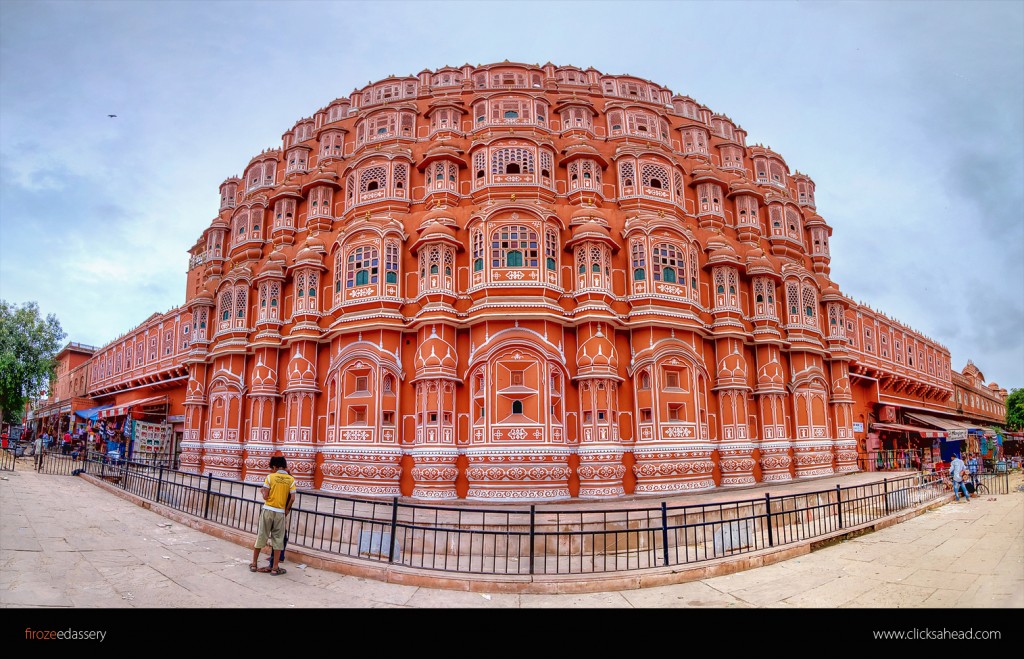
The signature building of Jaipur, Hawa Mahal – Palace of the Winds, is an admiring tourist attraction in India. Nestled in the heart of Jaipur, lovely five-storied palace was built in 1799 by the ruler of Kachhwaha Rajput Dynasty, Maharaja Sawai Pratap Singh. Lal Chand Ustad, the architect of the structure, constructed the palace using red & pink sandstone and in the form of Lord Krishna’s crown, the Hindu God.
Showcasing the fine specimen of Rajputana architecture style, the pyramid shape Wind Palace has its 953 ‘Jharokhas’ or windows adorned with intricate designs. According to the citations in the Indian history, the main motive behind the construction of the Hawa Mahal was to make the royal women enjoy freedom of watching the royal processions on the streets, through the Jharokhas, without being seen in public.
Fast Facts:
• Location: Jaipur (Rajasthan, India)
• Built By: Maharaja Sawai Pratap Singh
• Built In: 1799
• Architectural Style: Rajput Architecture
• Structural System: Red & Pink Sand Stone
• Architect: Lal Chand Usta
• Visiting Hours: 9:00 AM to 4:00 PM (Except Fridays and Gazetted Holidays )
• Best Time To Visit: October- March
• Entry Fee: INR 10 per person for Indians and INR 50 per person or foreign tourists.
History:
The Kachhwaha Rajput ruler, Sawai Pratap Singh, constructed Hawa Mahal in 1799 as a continuation of the Royal City Palace. Maharaja Sawai Pratap Singh was the grandson of Maharaja Sawai Jai Singh was is famed to build Jaipur.
This beehive structure is devotion of Sawai Pratap Singh to Lord Krishna. The same is reflected in the construction of the structure, which resembles as the crown of Lord Krishna.
There are various citations available behind the construction of the structure. Purdah system, followed by the Rajputs, is considered as one of the major reasons behind the construction of Hawa Mahal. The royal women were not allowed to appear in public. However, the wind palace was built with 953 ‘Jharokhas’ and screened balconies to allow the ladies watch the day-to-day events and royal processions on the streets, without being seen by the public.
Attractions of Hawa Mahal:
The unique architecture is one of the attracting features of the Hawa Mahal. The Wind Palace is constructed as a beehive castle with numerous small windows, called as ‘Jharokhas’. The structure is 50 ft high from the base.
This beehive structure has walls with the thickness of less than a foot. The elegant red color of the structure is due to the use of red & pink sandstones in its construction. The ‘Jharokhas’ or windows make the structure highly popular amidst tourists. These windows help in free circulation of air inside the palace.
The entrance door leads to a spacious courtyard, which is surrounded on three sides by two-storey buildings. The Hawa Mahal is a five-storey structure, featuring thickness of a single room in the top three stories. The bottom stories of the palace have courtyards.
You can witness the stark and plain interiors of the Hawa Mahal through the pillars and passages. There are no stairs available to reach the upper floors, thus, slopes are available to connect the stories. The palace also features an archeological museum. Moreover, visitors can also enjoy the panoramic view of the city from the top of the Hawa Mahal.
As there is very little to explore inside the Palace, the guests could also plan for excursion to nearby attractions such as Jantar Mantar, Amer Fort, Ram Niwas Bagh, Jain Temple, Sisodia Rani Garden, Govind Devji Temple, Nahargarh Fort, BM Birla Planetarium, Statue Circle, etc.
Getting In & Around:
The city of Jaipur is well-connected by regular flights to Mumbai, Delhi, Varanasi, Udaipur, Kolkata, Jodhpur, and Aurangabad. Proper rail networking also makes Jaipur accessible from all major cities of the country. Special luxury trains, such as Royal Rajasthan on Wheels, Maharajas Express and Palace on Wheels, which operate from Delhi for Jaipur. Apart from these, frequent and regular bus service is also available from Delhi, Rajasthan, Gujarat and Mumbai to reach Jaipur. Auto-rickshaw, taxis and horse-carts are available as local transport to move in and around the city of Jaipur.
Lodging & Food:
The Hawa Mahal does not offer any sort of accommodation facility. Thus, there are hotels ranging from heritage and luxury to budget hotels to offer comfortable accommodation, meeting the tastes and preferences of the guests. Modern facilities, exceptional services and Indian hospitality have assured a memorable stay for the guests. The hotels also feature in-house dining facility, where they can savor upon sumptuous delicacies. Apart from the in-house facility, the visitors could also checkout range of upscale restaurants to street side eateries in Jaipur.



Comment (0)